Adriana Butoi is an interdisciplinary artist who lives and works mainly in Mexico since 2011. With an artistic trajectory of over 25 years and collaborations with film directors and stage creators from over 12 countries, Adriana has a BA and MA in Acting Art and a PhD in Theater, but also a specialization at the Conservatoire National Supérieur d’Art Dramatique in Paris, where she was a scholarship holder during 2003-2004. A theoretician and practitioner of performative theatre, Adriana has founded and coordinated, since 2014, HÍBRIDOS laberintorio rizomático, an itinerant interdisciplinary platform through which she develops projects in the field of “extended stage”, as a researcher and practitioner.
Adriana, searching for information about you online, I had the feeling that there are two “Adrianas”: a very popular Romanian actress, who played in the 2000s on the stages of Bucharest and the country and had roles (bigger or smaller) in international films, respectively a foreign creator coming from the area of performative, multi- and trans-media research, with an interest in conscious artistic manifestations (of which themes and problems, you will tell me). They seem to be two creators, but also two ages of the performing arts. What is the line between the two figures and what would be, in the key of this metaphor of “twins”, your story in a nutshell?
Otherwise, a character in a Netflix show I recently watched was happy that, through the sum of coincidences & choices in her life, she landed in the “good life” but could have landed in many other lives… What coincidences or choices have landed you in your life now?
I have this picture of me on the shore of Lake Bacalar in the Yucatán Peninsula in 2010, before I moved to Mexico, setting out to create a school of the good life. After 12 years of mexicanness, I still want to create this itinerant school, obviously facilitating a rhizomatic pedagogy, one that de-hierarchizes thinking and knowing, micelles for a tenderly guided becoming towards deconstructing and reconstructing the human condition towards common well-being. A becoming in which the sweetness of utopias can breathe without fear the air of the epistemic changes of our times. I plan to outline the coordinates of this school of good living in the book I will assemble in 2024, called A Little Guide to Becoming for the Young Actor, which incorporates my doctoral thesis in theatre, A Voyage into the Androgynous Imaginarium. The magical theatre of existence.
So, the answer to your question is like the line of flight that unites all the coordinates of my life (from Adrianele Butoi into one), it is the empowering becoming for overcoming all systemic and epistemic conditioning. It is, above all, becoming fully aware of the need for diverse instrumentation for this. I wanted to become an artist and a humanist and I assimilated all kinds of knowledge, with a focus on acting-theatrical and film specializations that supported my inter- multi- pluri- trans- human feeling and potency.
It’s the first time, I think, that you return to Romania, after many years, with such a strong stage comeback: Kill the Fucking Bill(s) as part of Iridescent, a festival initiated by the National Dance Centre Bucharest. Your performance takes place at the Bulandra Theatre, at the opening of the festival, on 2 November, 7pm. Please tell me who these Bill(s) are and how you decided, artistically at least, to get rid of them.
Bills. Bills to settle, bills to pay on my list of becoming; performatively, in this show on Death List Five are some Mexican theatre directors, a few bitches in my life, Europe, the Butoi tulpa, the state, man, capital, history, theatre. Bills, accounts, restitution and resilience – a life project in progress.
I had an existential shock 5 years ago because of a betrayal, a stabbing of my dignity within friendship. The result was an extraction from the jungle habitat of our guild and a study of the dark core of personality, which involved a deconstruction of the stories from which such a reality was woven and a deep digging into the acidic soil of history – to more precisely identify the mechanisms of entrapment and manipulation. The result has been a conscious guiding of a process of healing and cleansing the meanings of what we identify as paramount in our becoming. It also resulted in this performative approach that I share with you on November 2 in Iridescent:
Kill the Fucking Bill(s) is the first theatrical-performative experience of my HYBRIDyo research project. Cuentas, restituciones y resiliencia / HYBRIDI. Bills, accounts, restitutions and resilience within HÍBRIDOS laberintorio rizomático, which traces in different formats my explorations of the performativity of the gesture of “making ethical peace with what is”, with a look at the history of humanity – between its joys and miseries – and its effects on micropolitics. The experience activates the archives of the research project, establishing a parallel narrative line to Quentin Tarantino’s Kill Bill, and aims to experience a symbolic revenge against the systems that caused the failure of personal and collective utopias in history
Practically, a conference space is transformed into a battle space, a theatre and a desert; academic discourse is thus subjected to games of representation that allow it to develop its wildest and most combative side. Kill… is an autofiction that aims to have the performative potency of a personal manifesto – about rhizomatic thinking and the “hybridentity” of an inter. multi. pluri. transcultural self… in full deconstruction. In the performance I establish different relations of meaning with the film Kill Bill and oppose a personal history charged with frustration, wounds and resentment to those macropolitical and micropolitical acts that destroy our lives – with the desire to create a kind of “revenge narrative” against historical reality as a product of capital, and thus achieve a state of satisfaction and harmony.
What is HÍBRIDOS laberintorio rizomático? What would you say to a researcher or practitioner in performing arts at the beginning of their career – I am of course also relating here to your teaching activity. And what would you like to have known before you started down all these converging corridors (writing, directing, theatre, archive, video art etc.)?
After eating a lot of black bread with lard in my communist childhood and a lot of theatricality and performativity on the white bread of capitalism after ’89, I became an interdisciplinary creator and performance artist. In my practices I autopsy the cold body of capitalism and perform an escape from the ideological plug of a white woman educated in the schools of real communism, intellectual daughter and artist of the proletariat subjugated by 20th century communisms and contemporary capitalisms. My academic and vocational trajectory has theatre as its main vector and, at the same time, brings together multiple other humanistic coordinates. I try to have the gaze of a highly participatory researcher and vocationally connect different ontological lines of flight.
With the creation of HÍBRIDOS laberintorio rizomático – an interdisciplinary platform that I founded in 2014 in Mexico City during a congress on Street Aesthetics organized by the National School of Anthropology and History (ENAH) – I imagined that it was possible to research, to manifest and transmit knowledge of a sensitive nature in an itinerant way from a platform of confluence of differences, a platform open to all disciplines and visions of being a person and a citizen in the world, visions that want to join forces for an epistemic change. This laboratorial construction has become a piece of interstice or a mobile language working to deconstruct and reconstruct society, a heterotopic fata morgana that de-centers and de-hierarchizes the thinking of the totalitarian, hetero-normative and patriarchal historical paradigm, while mobilizing practices of the real and the symbolic and co-producing presence and empathy for the creation of communitas.
Utopian and vocationally heterotopic, absolutely ambered by the sweetness of utopias, I find myself in an ontologically mobile language, paradoxically caught up in the great universal project of diversity and under the homogenizing force of the cosmos. (Auto)poiesis will never cease to debate my singularity on the tables of the world, and my formalized research will continue to inscribe itself in the infinite fabrics of performativity. Mexican philosopher Miroslava Salcido – with whom I have a filo-performative collaboration – opines that the researcher “must make use of the corporeality of thought to allow a performative turning of theory, which requires intellectual plasticity and critical substance to venture into the ever-failing attempt, but rewarding attempt to name an experience-event that, embedded in becoming, leads us to question not only the nature of our artistic approach, but also the place of art as a manifestation of a life whose gravitational axis is the body”. (Salcido, 2018)
So, dear young novice creators of a good life path, don’t stop deconstructing and reconstructing, recycling and exploring in up-cycling the archives of the past and the territories of becoming, affirming your singularity and standing together in the face of the inevitable and irreversible, accepting that everything is impermanent; identifying your urgencies, questioning and manifesting what appears to you as essential in your existence. Find new spaces of freedom beyond restrictions, reinvent the rules of homo ludens in the sense of exploring becoming beyond systemic formalizations, reformulate any inherited existential game, and ultimately open up a renewed interrogation of that “being a person and citizen in the world”. Narrating our lives becomes a political necessity that needs time and space and the cultivation of an agora to articulate.
Speech versus stance, rhetoric versus persuasion… Unfortunately, the class struggle continues, and the common pain against the established against the common good (sic!) constantly leads to a rebellious exercise of community, where perhaps something of what we call “feminisms” and “social liberation movements” can tenderly fill the spaces of the phallocratic establishment.
Theatricalities and performativities – hybridizing concepts, portals for the translation of ontological codes bearing all the flavor of the semantic and aesthetic deconstruction of many archives of history – lay eggs of diverse realities in this interstitial present of the 21st century, in the event-experiences themselves, of participants and observers alike, all acting, from different positions, simultaneously or in different canons of agreement, or even without a programmed agreement, between the parts of the action-performance, in the affirmation of liberating potency and spaces of freedom.
Assuming you are another, name, in a poetic sense, some of the people you might be. I would star with: the red-haired woman between two ages, in a bathrobe and slippers, smoking a cigarette in the staircase of the block, a woman suddenly seized by an uncontrollable sadness, but contained with style…
I am – potentially – a witch who burns the wickedness of the world on small pyres and wherever she can. I am – potentially – a healer singing icaros (the healing songs of the Shipibo natives of Peru) in an ayahuasca ceremony on a friendly moonlit night. I am – potentially – a psychotherapist in a white room on whose walls the visitor can, in need of accompaniment in the process of self-discovery and healing, project her needs and aspirations and confusions and hopes and cry out and sigh her offerings. I am – potentially – a cook who cooks delights from the simplest of materials to nourish altruism and faith in better. I am – potentially – a good mother of many children big and small, accompanied by a man whose face I have never seen. I am – potentially – Orlando, and I drink a transcendent and iridescent tea with Virginia Woolf on a terrace on Future Street. I am – potentially – a fire-faced intergalactic traveler with a right to visit the star Sirius. I am – potentially – what I am and what I am becoming.
What does the lab behind your work look like? How do you play in the “pre-” phase of your endeavors?
After all the theorizing and philosophizing you can see fit into this barrel of my intellectually capped rebel soul, it still fits to tell you that I am one of those who are constantly reorganizing and training to take real steps between the thresholds, interstices and languages of inter- and transdisciplinary practices. My spatial memory cohabits with the history and memory of creators’ antecedent and contemporary to me in an interstice of experience-event (acontecimiento, in Spanish), creators being for me producers of diverse performative presences and archives of a real history of the space-creation relationship. The “pre” phase of my performative approaches is research based on my emergencies of manifestation – to compensate reality with gestures that channel a possible harmonization and collective therapy. It may sound naive and hippy, but it’s as possible – and therefore real – a process with its benefits.
Back to Kill the Fucking Bill(s). Does your work (as an actress) still have “brothers” or “sisters” – among those very close to you? Any opposites or reverses? What should viewers expect, emotionally?
Exactly 10 years ago I performed in a show by Alberto Villarreal, a Mexican playwright and director of post-dramatic theatre, El lado B de la materia, and there I felt the need to integrate and at the same time disintegrate through autonomous performative gestures all the fierceness of theatrical matter and of that emotional-theatrical infrastructure formalized in the theatrical edifice. There followed all kinds of gestures that affirmed my need to step out of the old theatrical schemes and to differentiate between the rhetoric of discourse and the persuasion of living in the body the extra-ordinary that we strive to give to the audience in a cathartic package. We have torn down the fourth wall of the theatrical edifice and taken on Thespis and all the choruses of the domains of power, crystallizing into theatrical practices and performative interventions that allow for multiple hybrids and enable the activation of audiences towards punctual manifestations of micropolitics.
Tell me something memorable from the show’s rehearsals, possibly something from which we can get to know a bit about Anacarsis Ramos, the co-director and dramaturg of the show in which you are performing.
Here, Anacarsis answers: The show meant rehearsing a series of pop appropriation mechanisms, like a parasite needing someone else’s body, we told a life story by perverting an existing structure, images and symbols that were not our own. At the same time, as a playwright, I feel like a parasite taking Adriana’s very personal struggle and finding a way to insert my own concerns and little battles throughout, even in the most intimate and pornographic parts of the story. In the rehearsal process, what was most interesting (and challenging) for me as a director was to dialogue with the idea of “personayo“, “personaI“, Adriana Butoi’s concept and stance on fiction, which I broadly understood as a manifesto asking that she say nothing in the play that she didn’t feel deeply connected and affiliated with, as well as leave plenty of room for improvisation and the intervention of live text. This position has meant constantly analyzing and altering the map of forces that is normally established in rehearsals, where, whether we say it or not, the playwright and director remain the great holders of power through discourse. What interested me most about this retrospective work is that it is a way of generating political and aesthetic discourse through acting and performance.
Help me fill in the banks and, naturally, I ask you to be subjective: the best remedy for loneliness is…; there is no art without…; iridescence can be…
The best remedy for loneliness is sensitive work and contemplation of the multidimensionality of existence in “chaos”. It sounds abstract, but it’s real and it benefits. Recommendation.
There is no art without transcendence.
Iridescence can be a stop frame like this one from an old story of mine called “Androgynous or Rendez-vous with Eyed Rattles”:
(…) Ah, she should have put nail polish on herself, she could have done it while he was asleep, if he hadn’t fallen asleep on her hair. Call the boss to confirm… and these stairs that never end… and where does she find a cab in this neighborhood?! Somewhere on the first floors, classical music is playing. “It’s like the time of the powdered wigs…”…She comes out of the tower block, and looks worriedly right-left. It’s pouring down from above. She puts on her hood. A taxi comes speeding up and throws half a puddle at her, which stops in front of her. Stop-frame.
This familiar sensation tilts her head a little to one side. She looks perplexed behind her own irises and sees a ball of light with a tail coming through. It feels like a state of suspension. She doesn’t know what’s happening to her. She puts her other hand to her face and slowly sinks her teeth, tongue, cheeks, forehead, mouth, ears, nose and eyes into its socket. It feels like some kind of endless pleasure… like bliss… what is it?! She remembers that man in the tower block. It’s like she’s holding his head in her hand. Strange. That’s good. He’s finally okay.
I open my eyes and walk towards the door. Through the circle in the middle of the door I see a little boy with his finger still glued to the doorbell holding out a green hand. “Is this yours?” I have a sense of déjà vu. Of course, it was my hand, but I couldn’t understand what I was doing in this room. I put the glove on my hand and stick my head out the window. I’m on top of a tower block. A taxi driver suddenly stops his yellow and black car in front of the pavement and violently hits the back of his head 5 times. “Fucking bee!”. He squeezes the bee’s striped body between stubby fingers. “Look, it didn’t leave now!” he says, satisfied. Meanwhile the little boy has reached the front of the car and is drawing something on the dusty hood. I’d like to see what. I’m coming down! You can see it from here. I lean far over the sill and watch my white eye droop. I slowly reach out to catch it; the eye is held in suspension by the boy’s gaze. The hand grips it between fingers with reddened fingernails; baroque music is heard from the taxi radio, muffled by other frequencies. As if the cabbie’s stubby finger is searching insistently for the g-point of the radio box. A sort of smile curls my mouth.
The little boy stares into the eye between my reddened fingers and nods in confirmation.
I feel such happiness. Strange. I’ve felt that before. I feel like I’m a little late.
I’m going downstairs.
I’m in front of the tower block. I look anxiously right-left. The little boy has disappeared with the taxi. It’s pouring down from above. I let this rain fall on me. My hair sticks to my temples. I’ve felt that before. I open my eyes and see two rainbows weaving over the tower block. I take a few steps back to get a better view of their dance. I feel a strong jet hit my back. I’m thrown off balance. I fall. The sudden brake. Weird. It’s like hearing a mirror shatter. Rainbows pulsating together. Slower and slower. Like a heartbeat. Strange. There’s an ambulance siren.”
It’s November 2, 6:50 p.m. You’ve got 10 minutes and you’re on stage. The first lines of a song ring out in your head. Which song? And, more importantly, a face appears before your eyes from far away, perhaps long unseen, wishing you good luck. Who?
Qué será será, Wax Tailor… What will be will be…
I can see that little Adrianuta, with her big wet eyes, curious and happy, and her hair sweating on her forehead from all that running after chimeras, going deep into the forest in search of a clearing where the good sun will shine on her already mature face.
Thank you, Adriana.
Kill the Fucking Bill(s) as the opening of Iridescent Festival. November 2nd, 7 p.m., Bulandra Theatre.
POSTED BY
Mihai Ivașcu
Mihai Ivașcu (b. 1997, Bucharest) writes poetry and theater and works as a communication specialist. He holds a degree in Advertising, completed a master's degree at CESI with a focus on performing a...

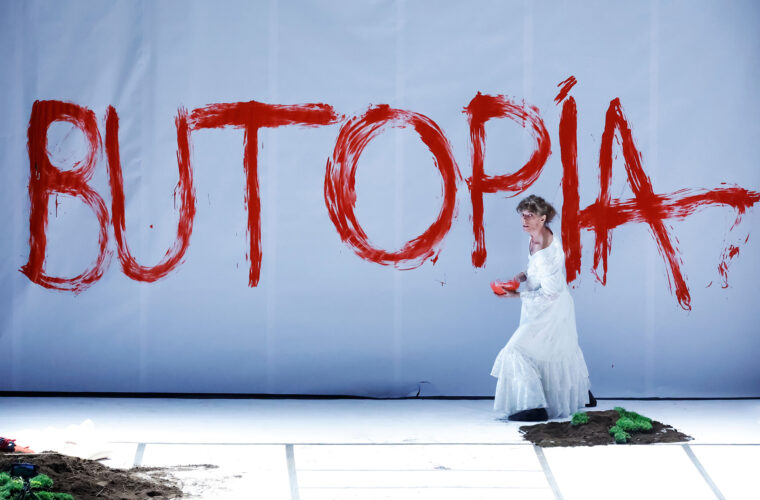
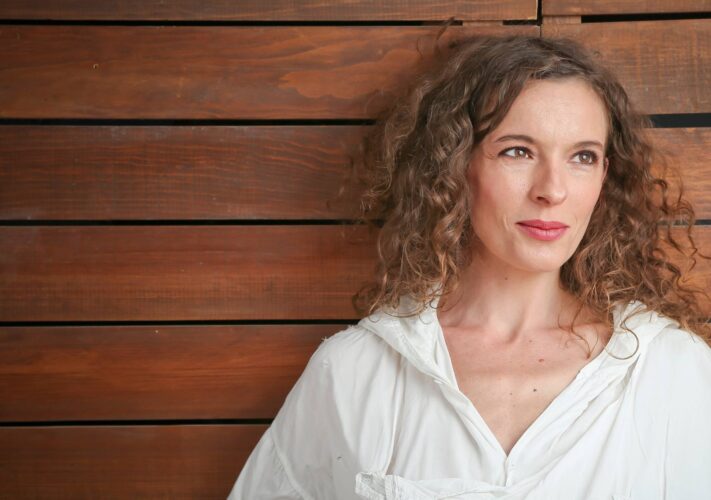

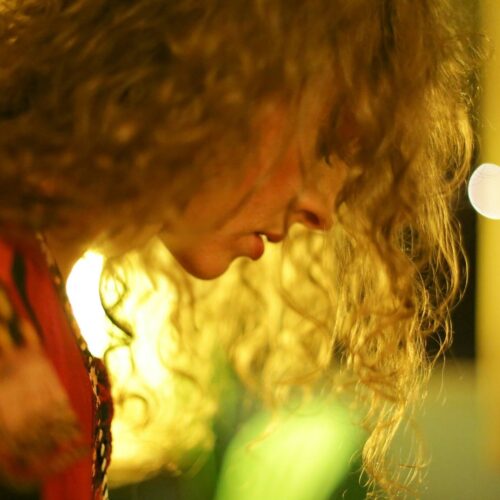
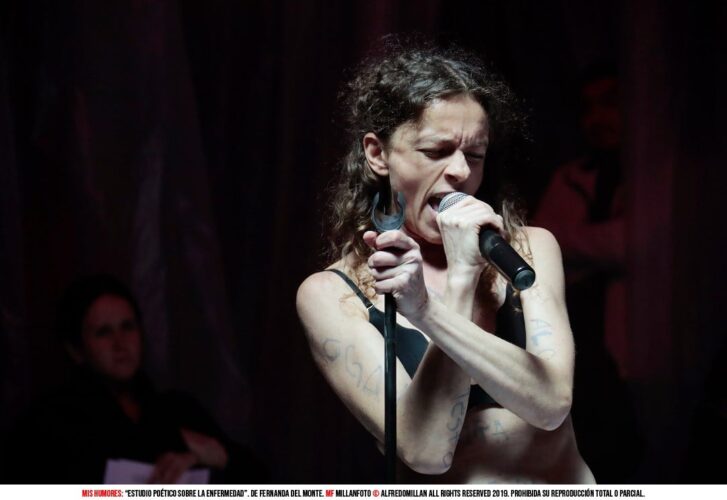
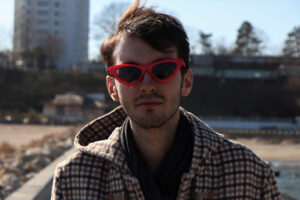
Comments are closed here.